HP Elite Dragonfly Max Review (Updated)
- Paul Thurrott
- Jul 28, 2021
-
8

UPDATE: I’ve updated this review to include information about this PC’s unique 5 MP webcam, which offers dramatically better image quality than the 720p webcams found in most premium portable PCs today. –Paul
While its name suggests a larger model, the Elite Dragonfly Max is more properly identified as a maxed-out, third-generation version of HP’s intriguing alternative to the also-premium EliteBook 1030 line. But little has changed from its predecessors, which is both good and bad.
Windows Intelligence In Your Inbox
Sign up for our new free newsletter to get three time-saving tips each Friday — and get free copies of Paul Thurrott's Windows 11 and Windows 10 Field Guides (normally $9.99) as a special welcome gift!
"*" indicates required fields
If you’re unfamiliar with the previous two Elite Dragonfly models, be sure to check out my initial HP Elite Dragonfly review and my follow-up about the second-generation Elite Dragonfly with Sure View Reflect and Tile. Compared to its direct predecessor, the HP Elite Dragonfly Max is a similarly subtle upgrade over the previous versions with newer components and a new black color that I find particularly attractive. So let’s start there.
Design
With previous versions of the Elite Dragonfly, you could get any color you wanted as long as it was Dragonfly Blue. I happened to really like that color, but I can see where some might find it controversial, and so it’s perhaps not surprising that HP has switched to a new “Striking Black” color for the Max. And go figure, I really like this color too. I just wish there were options: Previous Dragonfly models continue with the blue color and the Max is only available in black.

The new color reminds me a bit of the old black MacBook from many moons ago. But beyond that change, the Elite Dragonfly Max is physically identical to its predecessors, with the same versatile convertible/360 design, the same lightweight magnesium construction, and the same display size, keyboard and touchpad, and ports layout.

Like its predecessors, the Max and its magnesium body should prove durable over time, and HP notes that the system has passed 19 MIL-STD 810H tests.
I really like the design overall, but it’s showing its age, too. The power button is still on the left side of the device, rather than being on the keyboard where it wouldn’t be hit accidentally. The display is still 16:9, which is borderline unacceptable at this price level in 2021, and it has bigger than necessary top and bottom bezels as a result. The wrist rest, as before, is a bit small, and the fingerprint reader mars its surface rather than being integrated into the keyboard, as HP has since done with its other premium portable PCs. What was striking in late 2019 is starting to feel just a bit dated.
Don’t get me wrong, the Elite Dragonfly Max is a beautiful PC, and the matte black color will help it better blend in when traveling or in meetings. But HP has made big design strides elsewhere, and here it is simply continuing to offer the same design as before.
Display
HP only offers a single display to Elite Dragonfly Max customers, and while it’s a good one, it’s the same high-end 13.3-inch Full HD (1920 x 1080) display we saw on the second-generation refresh, with integrated Sure View Reflect Privacy functionality that’s toggled by a key in the function key row. It’s an incredibly bright display panel, throwing off 1000 nits of brightness, and it’s protected by Corning Gorilla Glass 5. But as noted above, the 16:9 aspect ratio is less than ideal. I would much prefer to see a 16:10 Full HD+ display at this price level.

Thanks to the Max’s convertible nature, the display also supports multitouch and AES-compatible smartpens. HP doesn’t bundle a pen with the Max, but it will sell you a color-matched Wacom AES 2.0 Pen with App Launch Button G3 at purchase time for about $75.
Internal components
Like other premium ultralight portable PCs, the Elite Dragonfly Max ships with quad-core 11th-generation Core processors, both with Intel Iris Xe integrated graphics, and you can choose between two: A Core i7-1165G7 or a slightly more powerful Core i7-1185G7. You also have a choice of 16 or 32 GB of RAM, and 512 GB, 1 TB, or 2 TB of PCIe NVMe SSD storage. These are high-end specifications for an ultra-portable like the Max
The review unit is outfitted with the Core i7-1185G7 processor, 16 GB of RAM, and 512 GB of storage, and I wasn’t surprised that it provided an ideal level of performance for the standard productivity tasks that I typically undertake. And I experienced little in the way of fan noise or heat, though there was some typical (for Intel) fan noise during certain operations, such as installing applications and system updates.
As with the second-generation Elite Dragonfly, the Max includes an integrated Tile M.2 module, which provides LoJack-style location services if the PC is lost or stolen. And yes, it works even if the PC is powered off. As before, the integrated Tile module is configured via a bundled Tile app, which can also be used for standalone Tile trackers and is accessible via an app for Android and iPhone too.
Connectivity
Connectivity is modern, with Wi-Fi 6 and Bluetooth 5 wireless capabilities. And you can add 4G/LTE (CAT 9) or 5G (CAT 20) cellular connectivity as an option. The review unit offers the latter, via a Qualcomm Snapdragon X55 cellular modem. (The 4G/LTE option uses an Intel XMM 7360 LTE Advanced chipset.)
Ports and expansion
While the layout of the expansion ports on the is unchanged from previous Elite Dragonfly generations, there has been one major change: The Thunderbolt 3/USB-C ports from previous versions have been upgraded to Thunderbolt 4/USB-C.
On the left, you’ll find a full-sized USB-A 3.1 port (with always-on charging capabilities), the power button, a nano lock slot, and a nano-SIM slot if you choose a cellular data option.

And on the right, you’ll see a full-sized HDMI 2.0 video port, a 3.5 mm combo audio jack, and two Thunderbolt 4/USB-C ports, either of which can be used for power using the bundled 65-watt power adapter.
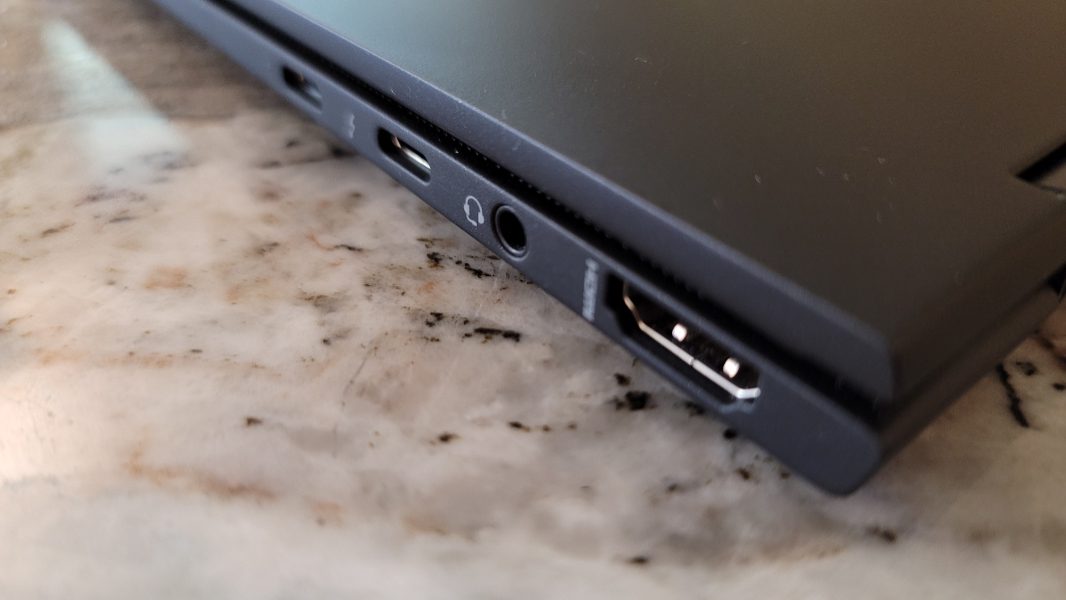
I would prefer to see one USB-C port on each side of the PC, and I wish the ports were further towards the back since the power cable can get in the way. But this is a great selection of modern and legacy ports and should meet most needs.
I wish it was better hidden in the keyboard, but the wrist rest-mounted fingerprint reader was fast and accurate, as always.
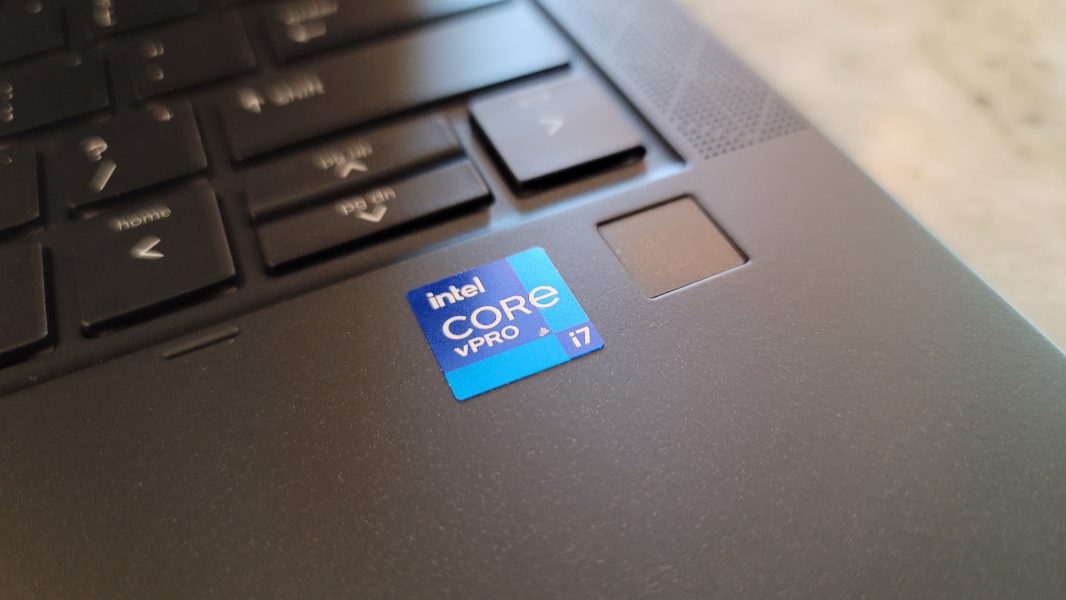
Audio and video
As with previous Elite Dragonfly models, the Max features four Bang & Olufson-optimized speakers—two top-firing and two bottom-firing—each of which is tied to a discrete smart amplifier. And as per my previous experience, this is a surprisingly capable sound system, with rich, clear sound that’s free of distortion. I watched action scenes from both Atomic Blond and Star Wars: The Last Jedi and was really impressed by the sound quality.
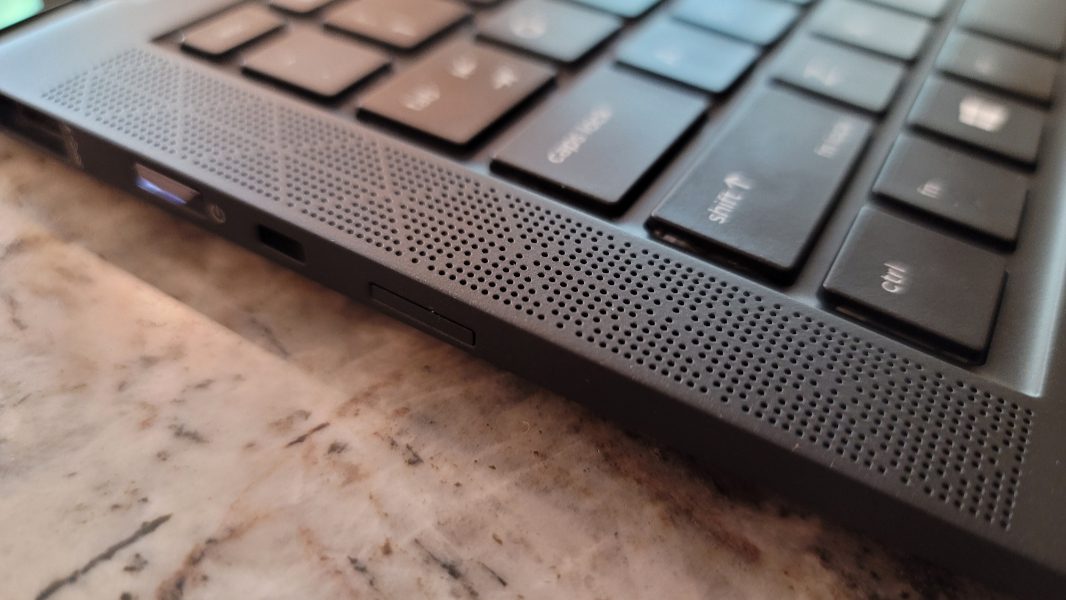
You can configure the audio configuration using an HP Audio Control app, and I was interested to see that HP now offers a browser plug-in for getting the best sound quality possible from web apps like YouTube and Netflix. I like that HP Audio Control can be configured to automatically detect the type of content you’re enjoying—music, videos, voice calls, and so on—and that seems to work well.
Unlike most premium portable PCs these days, including its predecessors, the Dragonfly Max ships with a 5 MP front-facing webcam instead of the more typical 720p shooter. So it’s much clearer and provides a less noisy image, which is ideal for this era of hybrid work and remote conference calls. The webcam can also be covered with a manual privacy shutter, which is always appreciated. Here’s a shot comparing a typical HP premium PC’s webcam, on the left, to the 5 MP webcam in the Dragonfly Max, on the right:

The Max also provides two front-facing microphones as before, but it also comes with two world-facing microphones, up from one in previous versions. And all of these microphones are now enhanced with AI-based noise cancelation that reduces ambient noises—sirens, plastic bags, paper crunching, and the like—and makes a big difference during all those work calls we’re still making from home.
Keyboard and touchpad
While I wish that HP had modernized the Max keyboard by including some of the useful changes it’s made to other premium portable PCs in the past year, this is still one of the very best keyboards I’ve ever used. It has an ideal typing experience, with a comfortable key feel, medium key throws, and quiet operation. This is a hard thing to explain, but I’ve spent my entire adult life with my hands on various keyboards, and this remains one of the very best portable keyboards I’ve ever used.

That said, I wish that the Max had lived up to its name and provided a larger 14-inch/16:10 display; this would have resulted in HP adding that right column of Home, PgUp, PgDn, and End keys at the right of the keyboard that I prefer so much. Instead, we have to make do with Fn key-based keyboard shortcuts for these commonly-needed actions, and that’s less than ideal. It doesn’t ruin the typing experience per se, but it’s a negative.

The touchpad—which HP describes as a “clickpad,” which I believe means it is fully electronic like the versions found on recent Apple portable Macs—is excellent and has been error-free. I didn’t even disable three- and four-finger gestures as I usually do. It’s “just right” from a size perspective, not too small and not too large.
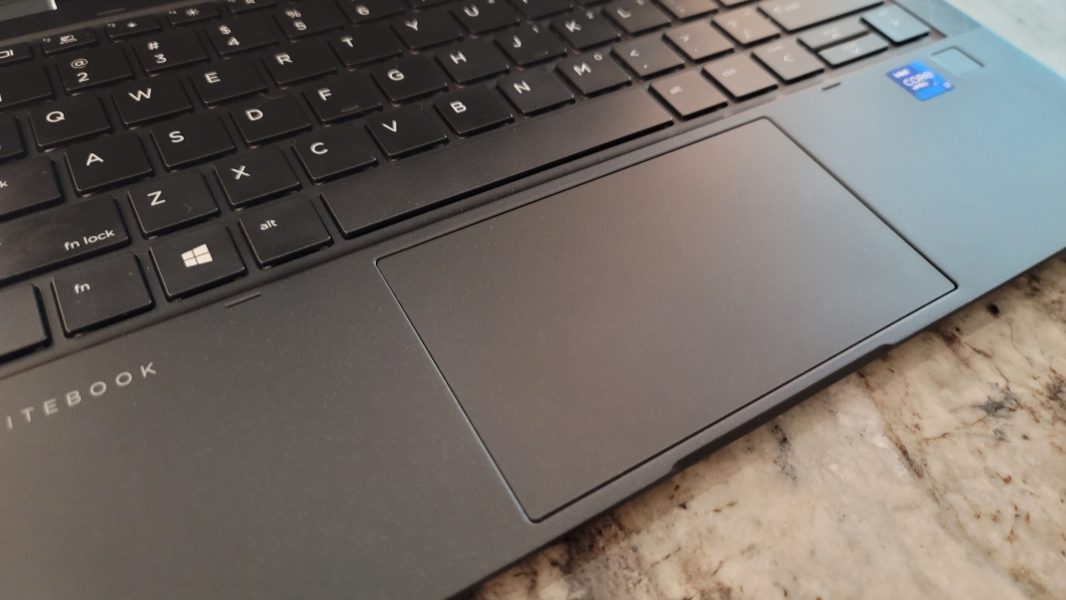
Portability
I’m not a fan of 16:9 displays, but it’s hard to argue with the resulting portability win, which can be partially attributed to the magnesium construction as well: The Elite Dragonfly Max weighs just under 2.5 pounds and is a joy to carry in a bag. Yes, that’s a bit more than the OG Dragonfly’s base weight of 2.2 pounds, but that product had a smaller 3-cell battery and delivered less battery life.
Battery life averaged under 8 hours, so a bit short of what I saw with the OG Dragonfly, but still excellent. That can be attributed to its large 4-cell, 56-watt-hour battery.
Software
There are over 15 HP-branded applications and utilities in the Elite Dragonfly Max’s Start menu, and that’s about 12 too many in my opinion. None can fairly be labeled as “crapware,” I guess—though an Adobe Free Trials app crosses that line—and most are related to the value-added business management and security services that HP makes available to this customer segment. But still. Surely, there is a way to scale down on this nonsense, perhaps via a first-boot experience that lets users or IT choose which to make available to users. There’s no need to beat this to death, but the bloatware on this PC is too much.
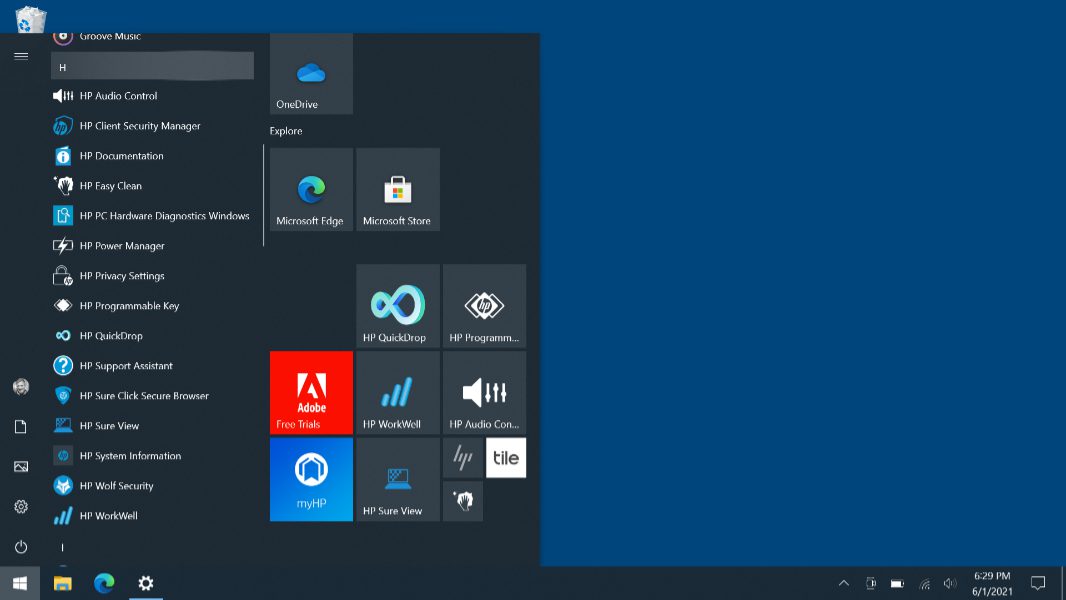
Pricing and configurations
While we’re speaking plainly, let me just say that the HP Elite Dragonfly Max is far too expensive. The least expensive configuration—with a Core i7-1165G7 processor, 16 GB of RAM, and 512 GB of SSD storage—costs an incredible $2400, about $1000 more than the premium PC norm. (OK, actually, you could configure it for about $2237 if you go with FreeDOS instead of Windows.) Bump up the processor, RAM, and storage, and add a smartpen and 5G networking, and the price could easily sail past—wait for it—$3700.
We can’t pretend that these prices make sense. But it’s important to remember that the Elite Dragonfly Max is, literally, the highest-end Dragonfly there is. It comes only in very high-end configurations, and it includes HP’s best 13.3-inch display and Tile integration, and it can be had with 4G or 5G cellular networking.
But if you love this design and want to save some money, you should check out at the very similar non-Max Elite Dragonfly. An entry-level system can be had for as little as $1600, and that one is truly entry-level, with a Core i3 processor, 8 GB of RAM, and 128 GB of SSD storage. But a more reasonable configuration with a Core i5 processor and 256 GB of storage will set you back about $1725. That’s still expensive, but it’s important to remember that the Elite lineup is aimed at businesses, not individuals and these PCs include 3 years of support in addition to a full suite of security and management solutions. Still too much? HP sells much less expensive but still excellent Spectre x360 products for individuals.
Recommendations and conclusions
The HP Elite Dragonfly Max is essentially an upgraded version of previous generation Dragonflies that provides what used to be added-cost upgrades—Sure View Reflect, Tile, the larger battery, and so on—and a new and less controversial color scheme. Thus, the “max” in the name refers to this system being maxed out, rather than a version with a larger display.
What that means is that the Dragonfly Max brings forward everything that was right about its predecessors, but also some of the blemishes, like the 16:9 display, the missing keyboard innovations, and the HP bloatware. None of that detracts from the central excellence of the Elite Dragonfly Max, but it’s important to know about, especially given this PC’s high cost.
This is one of the best ultra-portables I’ve ever used. But with a few important changes, including a 16:10 display and a few of HP’s recent keyboard innovations, it could be perfect.
At-a-glance
Pros
- Gorgeous design
- Thin and light, very portable
- Versatile convertible form factor
- Excellent keyboard and touchpad
- Surprisingly strong audio performance
- Great selection of ports
Cons
- So expensive
- 16:9 display
- Missing some modern keyboard innovations
- Too much bloatware